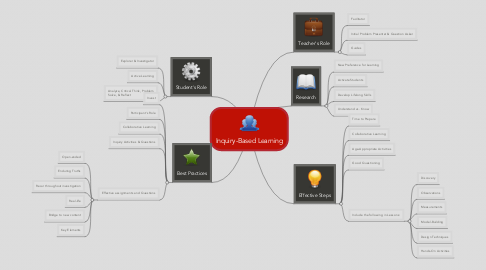Inquiry-Based Learning
by Kayla Barnhill


1. Student's Role
1.1. Explorer & Investigator
1.2. Active Learning
1.3. Analyze, Critical Think, Problem Solve, & Reflect
2. Best Practices
2.1. Invest
2.2. Participant's Role
2.3. Collaborative Learning
2.4. Inquiry Activities & Questions
2.5. Effective assignments and Questions
2.5.1. Open-ended
2.5.2. Enduring Truths
2.5.3. Recur throughout investigation
2.5.4. Real-life
2.5.5. Bridge to new content
2.5.6. Key Elements
3. Teacher's Role
3.1. Facilitator
3.2. Initial Problem Presenter & Question Asker
3.3. Guides
4. Research
4.1. New Preference for Learning
4.2. Activate Students
4.3. Develop Lifelong Skills
4.4. Understand vs. Know
5. Effective Steps
5.1. Time to Prepare
5.2. Collaborative Learning
5.3. Age-Appropriate Activities
5.4. Good Questioning
5.5. Include the following in Lessons:
5.5.1. Discovery
5.5.2. Observations
5.5.3. Measurements
5.5.4. Model-Building
5.5.5. Design Techniques
5.5.6. Hands-On Activities
